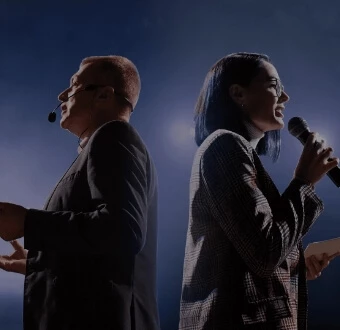 SPEAKERS
SPEAKERS
Embarking on 2024, public speaking evolves within the kaleidoscope of communication, or traditional communication.

In the kaleidoscope of communication, public speaking stands as an evolving art form, shaped by the currents of societal change. As we step into the realm of 2024, the landscape of public speaking is undergoing a profound metamorphosis, driven by technological leaps, changing audience demographics, and an unyielding demand for authenticity.
The traditional lecture format is giving way to an era of dynamic and immersive presentations. Audiences now expect speakers to harness cutting-edge technology, incorporating not only dynamic visuals but also interactive elements that invite participation.
Virtual and augmented reality (VR/AR) are becoming not novelties but essential tools, providing speakers with the ability to transport audiences into fully immersive environments. Plus, the rise of hybrid events blends physical and virtual elements, allowing speakers to transcend geographical boundaries and reach broader, more diverse audiences.
In the cacophony of information, audiences crave authenticity as an anchor. Scripted speeches are losing their luster, replaced by the allure of genuine, unfiltered storytelling. Speakers who share personal anecdotes, vulnerabilities, and experiences forge a connection that transcends the traditional speaker-audience dynamic.
This emphasis on authenticity not only humanizes the speaker but also cultivates a deep sense of trust and credibility. These are essential elements in capturing and retaining the attention of the modern, discerning audience.

The call for diversity and inclusivity echoes loudly in the corridors of public speaking. In 2024, audiences demand representation not only in speaker demographics but also in the very fabric of the topics discussed. Diverse communication styles are celebrated, ensuring that presentations resonate with a wide spectrum of audience members.
Language and content must go beyond mere acknowledgment and reflect a commitment to inclusivity. This ends up creating an environment where everyone feels not heard but valued.
Technological Integration
In the arsenal of a modern speaker, technology has become an indispensable ally, revolutionizing the art of public speaking. Artificial intelligence (AI) now plays a pivotal role, offering speech coaching tools that provide nuanced, personalized feedback for continuous improvement.
Wearable devices, armed with AI capabilities, analyze real-time audience reactions, empowering speakers to dynamically adapt their delivery based on the pulse of engagement. Furthermore, the integration of AI-driven analytics offers speakers invaluable insights, enabling them to finely calibrate their approach to align with the evolving preferences of their audience.

In an era where attention is the currency, speakers must craft messages that are short and simple. Long-winded speeches risk losing the audience's attention in the vast sea of information. So, mastering the art of brevity becomes not a skill but a necessity. Techniques such as powerful opening statements, compelling visuals, and engaging anecdotes become not mere stylistic choices but strategic imperatives in maintaining audience engagement throughout the presentation.
Interactive Q&A Sessions
The shift from passive spectators to active participants marks a paradigm shift in audience expectations. Interactive Q&A sessions have transitioned from being a postscript to a centerpiece, allowing speakers to directly engage with their audience.
Live polls and questions, facilitated by technology, transform presentations into collaborative experiences, fostering a sense of community and shared exploration. This not only provides valuable insights for speakers. It also creates an atmosphere where the audience feels not addressed but actively involved in the narrative.
Mastering the Virtual Stage
The seismic shift to virtual communication, accelerated by global events, has ushered in a new frontier for public speakers. Beyond the polished delivery of a message, speakers must now navigate the intricacies of the virtual stage.
Understanding virtual body language, using facial expressions effectively in a pixelated landscape, and maintaining a robust online presence become not additional skills but fundamental pillars for captivating virtual audiences. The virtual stage, once an auxiliary platform, is now a primary arena where speakers must shine.
The Role of Emotional Intelligence
In the tapestry of effective public speaking, emotional intelligence emerges as a transformative thread. Speakers who possess the acumen to discern and respond to the emotional nuances of their audience transcend the mere conveyance of information—they create a profound, lasting connection. Whether evoking laughter, empathy, or inspiration, emotional intelligence amplifies the impact of a presentation, etching it into the collective memory of the audience.
As we traverse the ever-evolving terrain of public speaking in 2024, the compass points to adaptability and innovation. Audiences have not raised the bar - they've rewritten the expectations. The speakers who thrive will be those who embrace innovative presentation formats, & prioritize authenticity as a guiding principle.
The future of public speaking is not a static stage with a lone orator - it's a dynamic, immersive experience where the speaker and the audience engage in a reciprocal dance. The journey ahead is not about meeting expectations - it's about exceeding them, continuously adapting, and leaving an indelible mark in the hearts and minds of the audience. Adaptability and innovation are the keys to unlocking success in this dynamic and ever-evolving public speaking landscape.